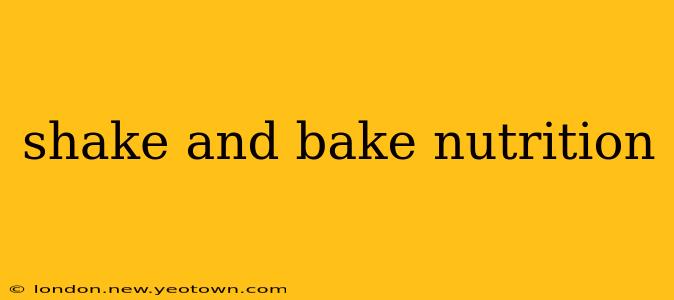The aroma of crispy, perfectly seasoned chicken—achieved with minimal effort—is a siren song to many a busy weeknight cook. Shake and bake, that iconic method of coating chicken (and sometimes other meats) in a flavorful mixture and baking until golden brown, promises convenience and deliciousness. But how does this seemingly simple meal stack up nutritionally? Let's delve into the details, uncovering the truth behind the tantalizing crunch.
What are Shake and Bake meals?
Shake and bake, in its most basic form, involves tossing raw chicken pieces (or other proteins) in a seasoned coating, typically a mix of flour, breadcrumbs, spices, and sometimes powdered milk or other additives. This coated protein is then baked until cooked through, resulting in a crispy exterior and tender interior. The convenience lies in the simplicity of preparation—no complex steps or extensive pre-cooking required. This ease of preparation is what makes shake and bake a favorite among busy families and individuals with limited cooking time.
How many calories are in a Shake and Bake meal?
The calorie count of a shake and bake meal varies significantly depending on several factors:
- The type of meat: Chicken breast will have fewer calories than chicken thighs or other richer meats.
- The amount of coating: A heavier coating naturally increases the calorie content.
- Added fats: Some shake and bake mixes include added fats like butter or oil, significantly impacting the calorie count.
- Serving size: A larger serving will naturally contain more calories.
Generally, a serving of shake and bake chicken can range from 250 to 400 calories or more, depending on the factors listed above. Always check the nutrition label of the specific shake and bake mix you're using for accurate calorie information.
Is Shake and Bake healthy?
Whether shake and bake is "healthy" is a complex question. It's not inherently unhealthy, but it's not a nutritional powerhouse either. The nutritional profile is heavily influenced by the specific mix used and the preparation method.
Potential Benefits:
- Convenience: The speed and ease of preparation make it a convenient option for busy lifestyles.
- Protein source: Shake and bake often utilizes lean protein sources like chicken breast, contributing to daily protein intake.
- Flavor and variety: Many shake and bake mixes offer a variety of flavors and seasonings, making it a palatable option.
Potential Drawbacks:
- High in sodium: Many commercial mixes are high in sodium, potentially contributing to high blood pressure if consumed regularly.
- High in saturated fat: Depending on the mix, saturated fat content can be considerable, potentially raising LDL ("bad") cholesterol levels.
- Processed ingredients: Commercial mixes often contain processed ingredients, additives, and preservatives.
- High in carbohydrates: The breadcrumb coating contributes significantly to the carbohydrate content.
What are the ingredients in Shake and Bake?
Ingredients vary widely between brands and recipes, but common components include:
- Flour: Provides structure to the coating.
- Breadcrumbs: Contributes to the crispy texture.
- Spices and seasonings: Enhance the flavor.
- Salt: Adds flavor, but often in high quantities.
- Dehydrated milk solids: Sometimes included for richness and texture.
- Other additives: May include emulsifiers, preservatives, and flavor enhancers.
How can I make a healthier Shake and Bake meal?
You can definitely improve the nutritional profile of shake and bake by making some simple adjustments:
- Use lean protein: Opt for chicken breast or turkey instead of higher-fat options.
- Reduce the coating: Use a lighter hand when coating the meat; excess coating adds extra calories and fat.
- Make your own mix: Create a homemade shake and bake mix using whole-wheat flour, oats, and your favorite herbs and spices. This gives you better control over the ingredients and sodium content.
- Bake, don't fry: Baking is a healthier alternative to frying, resulting in significantly fewer calories and fat.
- Control portion sizes: Be mindful of your serving size to manage calorie intake.
Is Shake and Bake good for weight loss?
Shake and bake, due to its potential high calorie and fat content, isn't ideally suited for weight loss unless consumed in moderation and as part of a well-balanced diet. Focusing on homemade versions with lean protein and reduced coating will help improve its suitability within a weight-loss plan.
Shake and bake can be a tasty and convenient meal option, but mindful choices regarding the mix used, portion sizes, and overall dietary habits are crucial for maximizing its nutritional value and minimizing potential drawbacks. Making informed decisions empowers you to enjoy this classic dish while maintaining a healthy and balanced lifestyle.

